计算机I/O
理解IO先要知道计算机对数据的输入输出是怎么处理的,下面一张图可以大致理解:
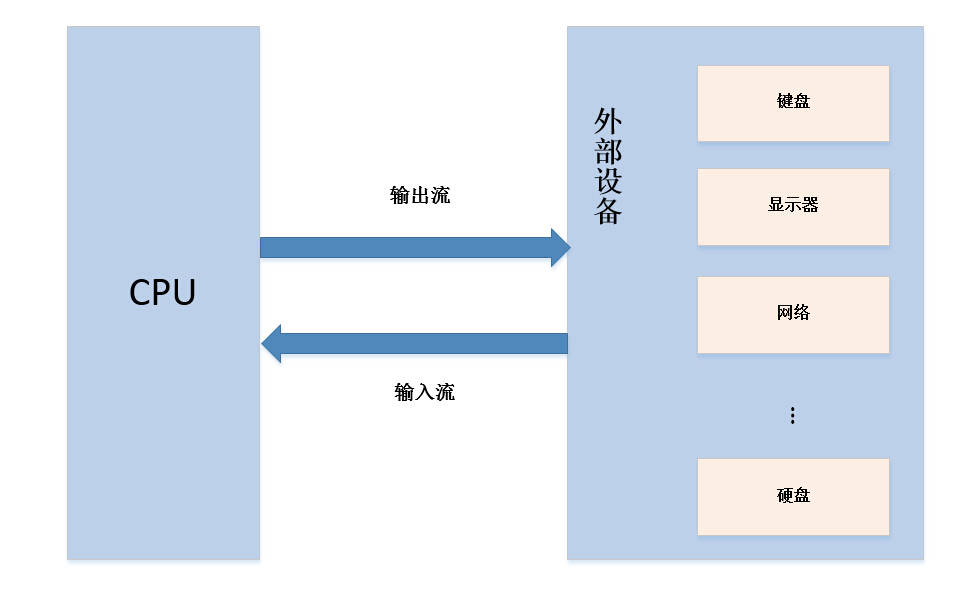
可以看出所谓输入是外部数据向CPU输入,而输出是CPU将数据输出到我们可见的地方,例如文件、屏幕等。而计算机通常是通过流来传递数据。
Java I/O
Java中的IO包中的类可以处理不同类型的流,例如:字节流(byte[])、字符流(character)、文件流、对象流等。
java.io中的抽象类:
- 处理字节流的抽象类:InputStream和OutputStream
- 处理过滤流的抽象类:FilterOutputStream和FilterInputStream
- 处理字符流的抽象类:Reader和Writer
- 处理压缩流的抽象类:InflaterInputStream和DeflaterOutputStream
它们之间的关系如下:

字符流
输入流Reader
基本的字符输入流的类结构如下,每个类的作用从类名大致可以猜出:
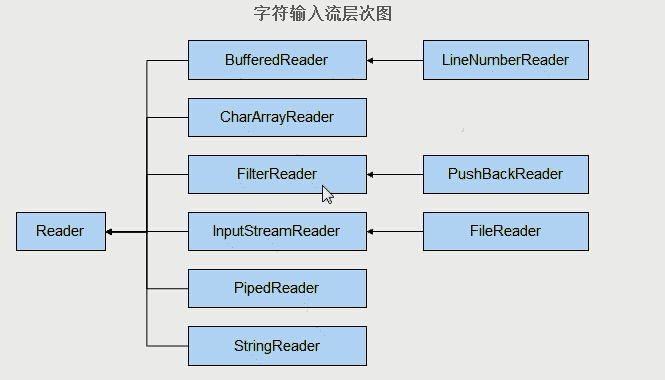
这里想强调的是出现的设计模式————装饰器模式:
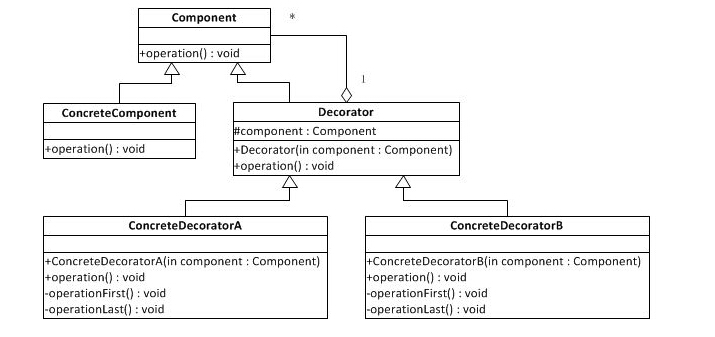
例如其中BufferedReader是对Reader接口的其他子类的一个装饰器,封装了其他Reader接口实现类,提供更方便的方法调用。
BufferedReader的构造器如下,初始化时需要传入一个对Reader接口的实现类的对象:
public BufferedReader(Reader in){}
实例代码,读取指定路径的文件内容并输出:
public class ReaderTest {
public static String read(String path) throws IOException {
//装饰器模式,BufferedReader包装了FileReader
BufferedReader reader = new BufferedReader(new FileReader(path));
String s;
StringBuilder sb = new StringBuilder();
while ((s = reader.readLine()) != null) {
sb.append(s + "
");
}
reader.close();
return sb.toString();
}
public static void main(String[] args) throws IOException {
System.out.println(read("D:/test.txt"));
}
}
可以看出BufferedReader封装了FileReader来提供更方便的文件输入功能。
输出流Writer
类比输出流,输出流很容易理解,类关系如下:

同样也用到了装饰器模式,下面直接用代码来说明问题,这段代码目的是将in.txt的内容写到out.txt中:
public class WriterTest {
public static void main(String[] args) throws IOException{
String inFile = "D:/in.txt";
String outFile = "D:/out.txt";
BufferedReader in = new BufferedReader(new StringReader(ReaderTest.read(inFile)));
PrintWriter out = new PrintWriter(new BufferedWriter(new FileWriter(outFile)));
String s;
int line = 1;
while ((s = in.readLine()) != null) {
out.println(line++ + ":" + s);
}
in.close();
out.close();
System.out.println(ReaderTest.read(outFile));
}
}
我们可以看出BufferedReader封装了StringReader,BufferedWriter封装了FileWriter。
字符流就说这么多吧,具体的类用的时候再去了解也不迟。
字节流
输入流InputStream
InputStream是以字节流来读取文件的,如果文件是图片或二进制等格式,则不能以字符流来读,需要InputStream来读取。
InputStream的子类关系如下图:
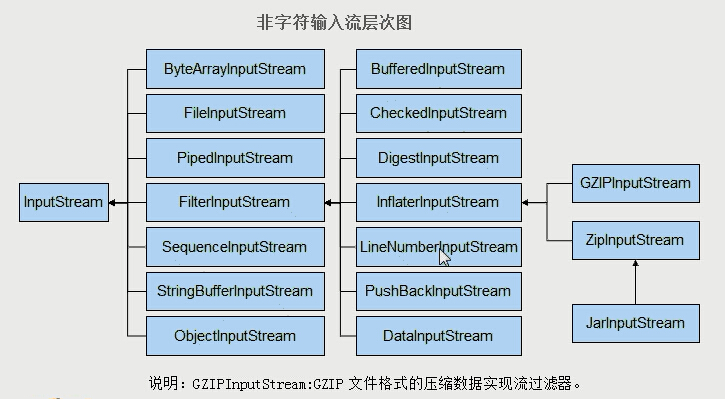
值得注意的是,字节流也可以转换成字节流,利用的是InputStreamReader类,该类封装了InputStream。下面的实例代码通过两种不同的方式来读取文件内容。其中readByStream是通过字节流,而readByReader是字符流。
public class InputStreamTest {
public static void readByStream(String path) {
File f = new File(path);
try {
InputStream in = new FileInputStream(f);
int b;
while ((b=in.read()) != -1) {
char c = (char)b;
System.out.printf("%c", c);
}
} catch (FileNotFoundException e) {
e.printStackTrace();
} catch (IOException e) {
e.printStackTrace();
}
}
public static void readByReader(String path) {
File f = new File(path);
try {
InputStream in = new FileInputStream(f);
BufferedReader reader = new BufferedReader(new InputStreamReader(in, "utf-8"));
String string;
StringBuilder sb = new StringBuilder();
while ((string = reader.readLine()) != null) {
sb.append(string);
}
System.out.println(sb.toString());
} catch (FileNotFoundException e) {
e.printStackTrace();
} catch (IOException e) {
e.printStackTrace();
}
}
public static void main(String[] args) {
String path = "D:/test.txt";
readByReader(path);
readByStream(path);
}
}
另外,值得注意的是,如果要读取中文,建议使用字符流,因为一个汉字占两个字节,而InputStream每次只会读取一个字节,因此会乱码。而InputStreamReader有一个构造函数可以设置文件编码,如上述代码中的new InputStreamReader(in, "utf-8")指定了文件编码问utf-8,因此可以很好的解决中文乱码问题。
输出流OutputStream
输出流OutputStream的作用类比于Writer,也非常容易理解,即通过字节流来把数据输出到文件、磁盘等设备中。关系如下图。
同InputStream一样,也有一个OutputStreamWriter包装了OutputStream,代码很简单我就不举例了。
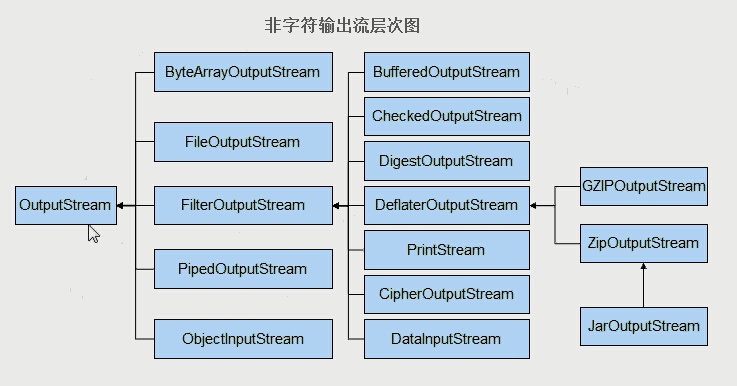
RandomAccessFile 随机存取
上面这两大类IO,虽然结构清晰,但是多少还是复杂了点,于是乎,Java封装了一个文件随机存取类————RandomAccessFile。

RandomAccessFile实现了两个接口,DataInput和DataOutput,因此它同时拥有读和写两个功能,方便了我们的使用。使用时需要指定打开文件的模式,可以是“r”只读,“rw”读写等。下面是实例代码:
public class RandomAccessTest {
public static void main(String[] args) {
String filePath = "D:" + File.separator + "test.txt";
File f = new File(filePath);
try {
RandomAccessFile write = new RandomAccessFile(f, "rw");
String str = "abc, hello, randomAccess!";
//把byte[]中的字节写入文件
write.write(str.getBytes());
System.out.println("写入文件完成...");
RandomAccessFile read = new RandomAccessFile(f, "rw");
String strRead;
StringBuilder sb = new StringBuilder();
while ((strRead = read.readLine()) != null) {
sb.append(strRead);
}
System.out.println("读取文件内容:" + sb.toString());
} catch (FileNotFoundException e) {
e.printStackTrace();
} catch (IOException e) {
e.printStackTrace();
}
}
}